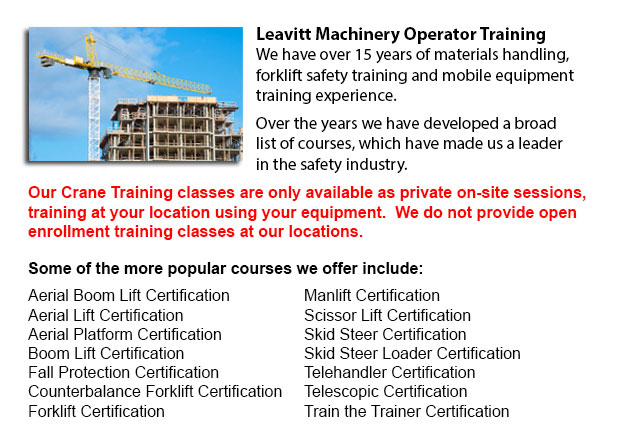
Cambridge Crane Certification - The Crane Certification training program includes subject matter recommended by industry regarding the safe and efficient operation of cranes. People training would learn the following: how to identify cranes and their component parts; pre-operational, operational and post-operating requirements; how to determine overall lift capacity; rigging components and inspection/rejection criteria; and needs particular to the work site where the individuals training will be operating.
Pre-operational requirements consist of assigning authority for the pre-operational check; doing the sequential pre-operational check based on the manufacturer's specifications or specifications certified by a professional engineer; checking the log book for comments; inspecting the work place for hazards and obstacles; checking hooks, chains, cables, crane movement and safety latches; ensuring the proper functioning of operational controls; and learning how to ensure the crane's disconnect switch/isolator is functioning right.
Operational requirements comprise identifying roles and responsibilities, and determining the requirement for a formal lift plan. People training will know how to carry out a hazard assessment related to environmental circumstances, physical situations and staff. Subject matter includes determining when to seek competent support, the safest route and destination of loads, and load weight and centre of gravity.
Trainees must be able to identify an over-capacity lift, in addition to be able to select correct rigging machine, select load restrictions, and to determine the safe spot for the crane to work from. Trainees would review both universal and site-specific crane signals for lifts, and techniques for loading, traveling and lifting. Proper maintenance practice will likewise be covered.
The person training would undergo an examination to test their understanding of emergency response techniques for various conditions, specially mechanical or electrical failures. They would be asked to describe shut down and parking procedures for safety and security, to follow tagging and lock out techniques, and to explain the reason why near misses are recorded and reported to the right individual. Log book records must be maintained.
People training will develop knowledge of rigging, particularly, establishing who has authority and responsibility for rigging, identifying different kinds of rigging, knowing storage procedures and load capacity ratings.
Post-operational requirements include entering defects or deficiencies, service and maintenance history in the log book, based on state, provincial and federal codes requirements.
Site-specific requirements could be incorporated into the safety training program according to the employer's requirements.
-
Cambridge Aerial Boom Lift Ticket
Cambridge Aerial Boom Lift Ticket - Aerial lifts can accommodate many tasks involving high and hard reaching places. Often used to perform routine upkeep in structures with elevated ceilings, prune tree branches, raise burdensome shelving units or me... More -
Cambridge Heavy Equipment Training
Cambridge Heavy Equipment Training - The two most common types of heavy equipment training are classed into the categories of machines; equipment that is fashioned with tracks and those with rubber tires. The tracked vehicle are heavy duty equipment... More -
Crane / Overhead Crane / Self-Erect Crane / Truck Mounted Crane / Hydraulic Cranes Training in Cambridge
Overhead cranes are likewise referred to as bridge cranes. They are a type of crane that has a hook and line mechanism which runs along a horizontal beam which runs along two widely separated rails. Several overhead cranes could be found in a long fa... More -
Cambridge Warehouse Forklift Training Classes
Cambridge Warehouse Forklift Training Classes - The reason for warehouse training classes are to raise the awareness of common workplace hazards. Those training would learn necessary warehouse safety procedures. An emphasis is placed on paying attent... More -
Cambridge Heavy Equipment Training School
Cambridge Heavy Equipment Training School - The heavy equipment operator courses would assist the operator in attaining the needed skills and knowledge they would need to be able to enter the workforce as an entry level operator. In this 12 week cour... More -
Cambridge Telehandler Training
Cambridge Telehandler Training - Telehandlers or also called Telescopic handlers are really popular piece of heavy construction machinery most often utilized in construction and agricultural industries. These machines have maximum reaching ability an... More -
Cambridge Boom Lift License
Cambridge Boom Lift License - To operate an aerial boom lift, operators should be certified through training which can be attained utilizing both practical training and classroom sessions and by attaining a boom lift license. Instruction must be give... More -
Cambridge Wheel Loader Training
Cambridge Wheel Loader Training - Normally, the various kinds of heavy equipment training are divided into 2 categories of equipment: those which have rubber tires and tracked vehicles. Tracked vehicles consist of items such as excavators, cranes, an... More

Forklift Certification Cambridge
TOLL FREE: 1-888-254-6157
Cambridge, Ontario
forkliftcertificationcambridge.com
Email Us
About Us


